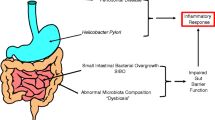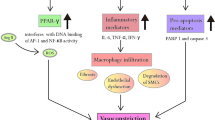Abstract
Background
Achalasia is an esophageal motility disorder with an unknown etiology. We aimed to determine the pathogenesis of achalasia by studying alterations in esophageal smooth muscle contraction and the associated inflammatory response, and evaluate the role of esophageal microbiota in achalasia development.
Methods
We analyzed esophageal mucosa and lower esophageal sphincter (LES) samples, obtained from patients with type II achalasia who underwent peroral endoscopic myotomy. Esophageal conditioned media obtained from patients were transferred into the mouse esophagus to determine whether the esophageal intraluminal environment is associated with achalasia.
Results
Approximately 30% of 20-kDa myosin light chains (LC20) was phosphorylated in LES from the control group under resting and stimulated conditions, whereas less than 10% of LC20 phosphorylation was detected in achalasia under all conditions. The hypophosphorylation of LC20 in achalasia was associated with the downregulation of the myosin phosphatase-inhibitor protein CPI-17. Th17-related cytokines, including IL-17A, IL-17F, IL-22, and IL-23A, were significantly upregulated in achalasia. α-Diversity index of esophageal microbiota and the proportion of several microbes, including Actinomyces and Dialister, increased in achalasia. Actinomyces levels positively correlated with IL-23A levels, whereas Dialister levels were positively associated with IL-17A, IL-17F, and IL-22 levels. Esophageal IL-17F levels increased in mice after oral administration of the conditioned media.
Conclusions
In LES of patients with achalasia, hypophosphorylation of LC20, a possible cause of impaired contractility, was associated with CPI-17 downregulation and an increased Th17-related immune response. The esophageal intraluminal environment, represented by the esophageal microbiota, could be associated with the development and exacerbation of achalasia.





Similar content being viewed by others
References
Boeckxstaens GE, Zaninotto G, Richter JE. Achalasia. Lancet. 2014;383:83–93.
Islam S. Achalasia. Semin Pediatr Surg. 2017;26:116–20.
Kahrilas PJ, Bredenoord AJ, Fox M, et al. The Chicago classification of esophageal motility disorders, v3.0. Neurogastroenterol Motil. 2015;27:160–74.
Yadlapati R, Kahrilas PJ, Fox MR, et al. Esophageal motility disorders on high-resolution manometry: Chicago classification version 4.0©. Neurogastroenterol Motil. 2021;33:e14058.
Clark SB, Rice TW, Tubbs RR, et al. The nature of the myenteric infiltrate in achalasia: an immunohistochemical analysis. Am J Surg Pathol. 2000;24:1153–8.
Furuzawa-Carballeda J, Aguilar-León D, Gamboa-Domínguez A, et al. Achalasia–an autoimmune inflammatory disease: A cross-sectional study. J Immunol Res. 2015;2015: 729217.
Kahrilas PJ, Boeckxstaens G. The spectrum of achalasia: lessons from studies of pathophysiology and high-resolution manometry. Gastroenterology. 2013;145:954–65.
Boeckxstaens GE. Achalasia: virus-induced euthanasia of neurons? Am J Gastroenterol. 2008;103:1610–2.
Somlyo AP, Somlyo AV. Ca2+ sensitivity of smooth muscle and nonmuscle myosin II: modulated by G proteins, kinases, and myosin phosphatase. Physiol Rev. 2003;83:1325–58.
Eto M, Senba S, Morita F, et al. Molecular cloning of a novel phosphorylation-dependent inhibitory protein of protein phosphatase-1 (CPI17) in smooth muscle: its specific localization in smooth muscle. FEBS Lett. 1997;410:356–60.
Ihara E, Moffat L, Ostrander J, et al. Characterization of protein kinase pathways responsible for Ca2+ sensitization in rat ileal longitudinal smooth muscle. Am J Physiol Gastrointest Liver Physiol. 2007;293:G699-710.
Eto M, Kitazawa T. Diversity and plasticity in signaling pathways that regulate smooth muscle responsiveness: Paradigms and paradoxes for the myosin phosphatase, the master regulator of smooth muscle contraction. J Smooth Muscle Res. 2017;53:1–19.
Ohama T, Hori M, Momotani E, et al. Intestinal inflammation downregulates smooth muscle CPI-17 through induction of TNF-alpha and causes motility disorders. Am J Physiol Gastrointest Liver Physiol. 2007;292:G1429–38.
Inoue H, Sato H, Ikeda H, et al. Per-oral endoscopic myotomy: a series of 500 patients. J Am Coll Surg. 2015;221:256–64.
Takeya K, Kaneko T, Miyazu M, et al. Addition of urea and thiourea to electrophoresis sample buffer improves efficiency of protein extraction from TCA/acetone-treated smooth muscle tissues for phos-tag SDS-PAGE. Electrophoresis. 2018;39:326–33.
Takeya K, Loutzenhiser K, Shiraishi M, et al. A highly sensitive technique to measure myosin regulatory light chain phosphorylation: the first quantification in renal arterioles. Am J Physiol Ren Physiol. 2008;294:F1487–92.
Kinoshita E, Kinoshita-Kikuta E, Takiyama K, et al. Phosphate-binding tag, a new tool to visualize phosphorylated proteins. Mol Cell Proteomics. 2006;5:749–57.
Woodsome TP, Eto M, Everett A, et al. Expression of CPI-17 and myosin phosphatase correlates with Ca(2+) sensitivity of protein kinase C-induced contraction in rabbit smooth muscle. J Physiol. 2001;535:553–64.
Iboshi Y, Nakamura K, Fukaura K, et al. Increased IL-17A/IL-17F expression ratio represents the key mucosal T helper/regulatory cell-related gene signature paralleling disease activity in ulcerative colitis. J Gastroenterol. 2017;52:315–26.
Nishihara Y, Ogino H, Tanaka M, et al. Mucosa-associated gut microbiota reflects clinical course of ulcerative colitis. Sci Rep. 2021;11:13743.
De Vrieze J, Pinto AJ, Sloan WT, et al. The active microbial community more accurately reflects the anaerobic digestion process: 16S rRNA (gene) sequencing as a predictive tool. Microbiome. 2018;6:63.
Moen AEF, Lindstrøm JC, Tannæs TM, et al. The prevalence and transcriptional activity of the mucosal microbiota of ulcerative colitis patients. Sci Rep. 2018;8:17278.
Bolyen E, Rideout JR, Dillon MR, et al. Reproducible, interactive, scalable and extensible microbiome data science using QIIME 2. Nat Biotechnol. 2019;37:852–7.
Callahan BJ, McMurdie PJ, Rosen MJ, et al. DADA2: High-resolution sample inference from Illumina amplicon data. Nat Methods. 2016;13:581–3.
Segata N, Izard J, Waldron L, et al. Metagenomic biomarker discovery and explanation. Genome Biol. 2011;12:R60.
Xiaopeng B, Tanaka Y, Ihara E, et al. Trypsin induces biphasic muscle contraction and relaxation via transient receptor potential vanilloid 1 and neurokinin receptors 1/2 in porcine esophageal body. Eur J Pharmacol. 2017;797:65–74.
Takeya K, Wang X, Kathol I, et al. Endothelin-1, but not angiotensin II, induces afferent arteriolar myosin diphosphorylation as a potential contributor to prolonged vasoconstriction. Kidney Int. 2015;87:370–81.
Trinkle-Mulcahy L, Ichikawa K, Hartshorne DJ, et al. Thiophosphorylation of the 130-kDa subunit is associated with a decreased activity of myosin light chain phosphatase in alpha-toxin-permeabilized smooth muscle. J Biol Chem. 1995;270:18191–4.
Ohama T, Hori M, Fujisawa M, et al. Downregulation of CPI-17 contributes to dysfunctional motility in chronic intestinal inflammation model mice and ulcerative colitis patients. J Gastroenterol. 2008;43:858–65.
Kim JI, Urban M, Young GD, et al. Reciprocal regulation controlling the expression of CPI-17, a specific inhibitor protein for the myosin light chain phosphatase in vascular smooth muscle cells. Am J Physiol Cell Physiol. 2012;303:C58-68.
Fujiwara H, Suchi K, Okamura S, et al. Elevated serum CRP levels after induction chemoradiotherapy reflect poor treatment response in association with IL-6 in serum and local tumor site in patients with advanced esophageal cancer. J Surg Oncol. 2011;103:62–8.
Qiu JG, Wang L, Liu WJ, et al. Apigenin inhibits IL-6 transcription and suppresses esophageal carcinogenesis. Front Pharmacol. 2019;10:1002.
Soares-Lima SC, Gonzaga IM, Camuzi D, et al. IL6 and BCL3 expression are potential biomarkers in esophageal squamous cell carcinoma. Front Oncol. 2021;11: 722417.
Wang LS, Chow KC, Wu CW. Expression and up-regulation of interleukin-6 in oesophageal carcinoma cells by n-sodium butyrate. Br J Cancer. 1999;80:1617–22.
Atarashi K, Tanoue T, Ando M, et al. Th17 cell induction by adhesion of microbes to intestinal epithelial cells. Cell. 2015;163:367–80.
Honda K, Littman DR. The microbiota in adaptive immune homeostasis and disease. Nature. 2016;535:75–84.
Di Pilato V, Freschi G, Ringressi MN, et al. The esophageal microbiota in health and disease. Ann N Y Acad Sci. 2016;1381:21–33.
Fillon SA, Harris JK, Wagner BD, et al. Novel device to sample the esophageal microbiome–the esophageal string test. PLoS ONE. 2012;7: e42938.
Gagliardi D, Makihara S, Corsi PR, et al. Microbial flora of the normal esophagus. Dis Esophagus. 1998;11:248–50.
Norder Grusell E, Dahlén G, Ruth M, et al. Bacterial flora of the human oral cavity, and the upper and lower esophagus. Dis Esophagus. 2013;26:84–90.
Pei Z, Bini EJ, Yang L, et al. Bacterial biota in the human distal esophagus. Proc Natl Acad Sci U S A. 2004;101:4250–5.
Liu N, Ando T, Ishiguro K, et al. Characterization of bacterial biota in the distal esophagus of Japanese patients with reflux esophagitis and Barrett’s esophagus. BMC Infect Dis. 2013;13:130.
Yang L, Lu X, Nossa CW, et al. Inflammation and intestinal metaplasia of the distal esophagus are associated with alterations in the microbiome. Gastroenterology. 2009;137:588–97.
Benitez AJ, Hoffmann C, Muir AB, et al. Inflammation-associated microbiota in pediatric eosinophilic esophagitis. Microbiome. 2015;3:23.
Harris JK, Fang R, Wagner BD, et al. Esophageal microbiome in eosinophilic esophagitis. PLoS ONE. 2015;10: e0128346.
Yang L, Chaudhary N, Baghdadi J, et al. Microbiome in reflux disorders and esophageal adenocarcinoma. Cancer J. 2014;20:207–10.
Yang L, Francois F, Pei Z. Molecular pathways: pathogenesis and clinical implications of microbiome alteration in esophagitis and barrett esophagus. Clin Cancer Res. 2012;18:2138–44.
Ng SC, Bernstein CN, Vatn MH, et al. Geographical variability and environmental risk factors in inflammatory bowel disease. Gut. 2013;62:630–49.
Zuo T, Lu XJ, Zhang Y, et al. Gut mucosal virome alterations in ulcerative colitis. Gut. 2019;68:1169–79.
Japan Esophageal Society. Descriptive rules for achalasia of the esophagus, June 2012: 4th Edition. Esophagus 2017;14:275–289.
Jankovic J, Milenkovic B, Skrobic O, et al. Achalasia subtype differences based on respiratory symptoms and radiographic findings. Diagnostics (Basel). 2023;13:2198.
Crespin OM, Tatum RP, Xiao K, et al. The relationship between manometric subtype and outcomes of surgical treatment for patients with achalasia: Achalasia: manometric subtypes. Surg Endosc. 2017;31:5066–75.
Patel DA, Lappas BM, Vaezi MF. Diagnostics (Basel). An overview of achalasia and its subtypes. Gastroenterol Hepatol (N Y). 2017;13:411–21.
Acknowledgements
This study was supported in part by the Japan Society for the Promotion of Science KAKENHI (20K08334, 22K19530, 23K07440) and the Japan Agency for Medical Research and Development (AMED) (21lk0201144h001, 22lk0201144h002, and 23lk0201144h003).
Author information
Authors and Affiliations
Contributions
Conceptualization: HI, EI, KT, KM, and MO; Methodology: HI, EI, KT, KO, YH, TS, FS, ME, JN, and YO; Formal analysis and investigation: HI, KT, KM, XB, YT, TS, FS, and ME; Writing-original draft preparation: HI, EI, and KT; Writing-review and editing: ME, JN, YO, MN, HI, and YO; Funding acquisition: EI and YO; Resources: EI and YO; Supervision: HI and YO. All authors have read and approved the final manuscript.
Corresponding author
Ethics declarations
Conflict of interest
The authors declare no conflicts of interest related to this study. E.I. belongs to an endowed course supported by companies including Miyarisan Pharmaceutical Co., Ltd., Fujifilm Medical Co., Ltd., Terumo Corporation, FANCL Corporation and Muta Hospital. E.I. received a lecture honorarium from EA Pharma Co., Ltd., Viatris Inc. and Takeda Pharmaceutical Company. Y.O. conducted collaborative research with Fujifilm Medical Co., Ltd. and the FANCL Corporation. The other authors have no other conflicts of interest to declare in relation to this study.
Additional information
Publisher's Note
Springer Nature remains neutral with regard to jurisdictional claims in published maps and institutional affiliations.
Supplementary Information
Below is the link to the electronic supplementary material.
Rights and permissions
Springer Nature or its licensor (e.g. a society or other partner) holds exclusive rights to this article under a publishing agreement with the author(s) or other rightsholder(s); author self-archiving of the accepted manuscript version of this article is solely governed by the terms of such publishing agreement and applicable law.
About this article
Cite this article
Ikeda, H., Ihara, E., Takeya, K. et al. The interplay between alterations in esophageal microbiota associated with Th17 immune response and impaired LC20 phosphorylation in achalasia. J Gastroenterol 59, 361–375 (2024). https://doi.org/10.1007/s00535-024-02088-w
Received:
Accepted:
Published:
Issue Date:
DOI: https://doi.org/10.1007/s00535-024-02088-w




